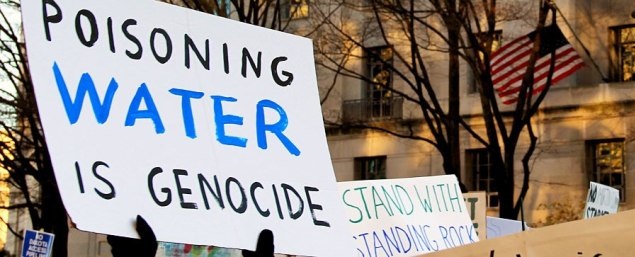
( – promoted by navajo)
Even with the vast improvements to environmental protection over the past few decades, there are still more than 1.3 billion people worldwide that live in hazardous and unhealthy physical environments. The generation and transportation of unsafe waste has been known to cause significant health, environmental, legal, political, and ethical dilemmas.
The systematic destruction of indigenous people’s land and the poisoning of Native Americans on reservations both have their roots in economic exploitation, racial oppression, devaluation of human life and the natural environment, and corporate greed. Due to unequal power arrangements, the rich have been able to get rid of their toxic waste by exploiting the poor. Developing nations sometimes have no choice but to allow the shipping of hazardous waste into their borders. Most people of color communities in the U.S. and poor nations around the world are forced to sacrifice their public health in order to create jobs and promote economic development. Such waste often results in an increased number of children diagnosed with asthma, brain cancer, mesothelioma, and other serious health problems.
This unfair treatment can be described as “environmental racism” and “radioactive colonialism.” There has been a direct correlation between the exploitation of land and the exploitation of people. Native American’s have had to deal with some of the worst pollution in the entire country. Native American communities are prime targets for waste trading.
Winona LaDuke, author of “All Our Relations: Native Struggles for Land Rights and Life,” sums up the idea of “radioactive colonialism,” stating:
While Native peoples have been massacred and fought, cheated, and robbed of their historical lands, today their lands are subject to some of most invasive industrial interventions imaginable. According to the Worldwatch Institute, 317 reservations in the United States are threatened by environmental hazards, ranging from toxic wastes to clearcuts.
Reservations have been targeted as sites for 16 proposed nuclear waste dumps. Over 100 proposals have been floated in recent years to dump toxic waste in Indian communities. Seventy-seven sacred sites have been disturbed or desecrated through resource extraction and development activities. The federal government is proposing to use Yucca Mountain, sacred to the Shone, a dumpsite for the nation’s high-level nuclear waste.
Today, millions of Americans have an increased awareness of the threat of chemical, biological, and environmental toxins. The tragic events of 9/11, the Anthrax scare, and even more recently; the catastrophic events in Japan, have heightened concern and fear of potential exposure. What most people don’t know, however, is that toxic waste exposure is not new for many people of color. So many communities are forced to live next to chemical industries that spew poisons into their air, water, and land. For these people, asthma, mesothelioma, disease, and cancer are just side effects that come with the territory. And with the mesothelioma life expectancy lasting only 14 months, the results can be devastating. These communities endure a form of “toxic” terror twenty-four hours a day and seven days a week.
the Yucca Mountain reference is from 2002.